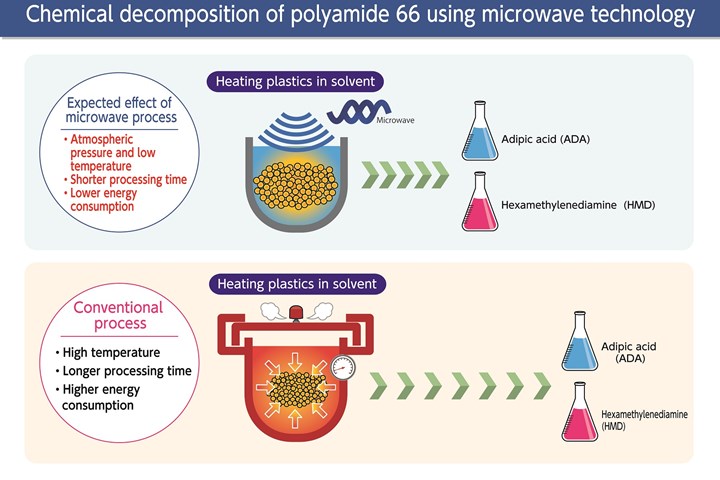Joint Project Will Demonstrate Recycling Polyamide 66 Using Microwave Technology
Materials producer Asahi Kasei and recycling technology developer Microwave Chemical announced a joint chemical recycling project.
Asahi Kasei and Microwave Chemical have launched a joint demonstration project with the objective of commercializing a chemical recycling process for polyamide 66 using microwave technology. The process utilizes microwaves to depolymerize PA66 and directly obtain hexamethylenediamine and adipic acid, the six-carbon monomers it is named for. The monomers can then be used to manufacture new PA66. In the demonstration, scraps from manufacturing and post-use waste material of PA66 for airbags and automobile parts are depolymerized.

The use of microwaves is expected to reduce energy needed for depolymerization.
Photo Credit: Microwave Chemical
Since 2021, laboratory scale studies have confirmed the high-yield depolymerization of PA66 using microwaves, as well as subsequent processes for separation and purification of the monomer products. Microwave’s proprietary PlaWave technology operates at lower temperatures and has lower energy requirements than conventional processes for depolymerization of PA66.
Asahi Kasei currently produces Leona 66, an engineered PA66, from fossil fuel-derived hexamethylenediamine and adipic acid, with automotive and electronics applications.
Benchtop demonstration trials are planned for 2024, with a decision on commercialization expected by 2025. Microwave Chemical is also working to expand the types of materials its PlaWave technology can be used to chemically recycle, including PMMA, PU foam, automotive shredder residue, and others.
Related Content
-
Prices of Volume Resins Generally Flat or Lower
Exceptions in early March were PP and PS, which moved up solely due to feedstock constraints, along with slight upward movement in PVC and PET.
-
Tracing the History of Polymeric Materials, Part 26: High-Performance Thermoplastics
The majority of the polymers that today we rely on for outstanding performance — such as polysulfone, polyethersulfone, polyphenylsulfone and PPS — were introduced in the period between 1965 and 1985. Here’s how they entered your toolbox of engineering of materials.
-
Prices Bottom Out for Volume Resins?
Flat-to-down trajectory underway for fourth quarter for commodity resins.













